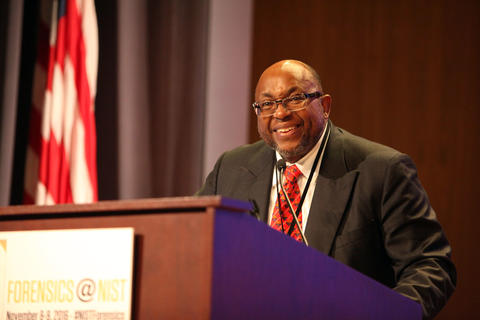Forensics@NIST 2016: Practitioners and Researchers Meet at a Critical Time for Forensic Science
A video archive and downloadable presentations are now available online.

NIST director Dr. Willie May delivers opening remarks at the Forensics @ NIST conference, November 8, 2016.
On November 8th and 9th, 2016, experts gathered for the fourth biennial Forensics @ NIST conference, where scientists from the National Institute of Standards and Technology (NIST) presented their latest research on ballistic toolmarks, fingerprints, digital forensics, trace evidence, DNA profiling, and more. In addition, experts from the NIST-funded Center for Statistics and Applications in Forensic Evidence discussed their efforts to bring new probabilistic methods to bear on forensic evidence.
More than 250 forensic experts attended, including many from the nation’s largest crime labs, and several hundred more participated via webcast. This gathering took place at a time of increased scrutiny for many of the forensic disciplines that the audience represented. Most recently, a report from the President’s Council of Advisors for Science and Technology (PCAST) argued that additional research is needed to establish the scientific validity of several forensic techniques that are routinely presented in the courtroom.
So it was timely, if potentially awkward, that the keynote speaker was a well-known advocate of reform. In his address, Jules Epstein, a professor and the director of advocacy programs at the Temple University Beasley School of Law and a member of the National Commission on Forensic Science, criticized both the forensic profession and his own legal profession for not moving quickly enough to change the practices that he and others argue can lead to miscarriages of justice.
But Epstein’s criticisms were presented constructively and with sincere admiration for the technical expertise that so many forensic practitioners bring to their work. “I’ve had the privilege of working with some of the best ballistics experts in the country,” he said, giving a shout out to one of the disciplines that has come in for criticism lately. “They could see things I could never see.”
But, he argued, forensic experts must do better, particularly when measuring and communicating how well a piece of evidence, such as a fingerprint or bullet, corresponds to a proposed match. “Embrace statistics,” he urged.
That sentiment seemed to underlie many of the presentations that followed. None of the NIST researchers who presented their work are practicing forensic scientists. They are chemists, physicists, biologists, and engineers. But they are experts in metrology—the science of measurement—and they are developing new and better ways to measure things objectively, accurately, and with known uncertainties, and to express those measurements in statistically meaningful ways.
For example, researchers from NIST’s Ballistics and Toolmarks group are developing advanced methods for forensic firearms identification. They are using 3D microscopes to scan the surfaces of bullets and cartridge cases, and their presentations discussed new ways to measure and compare those surfaces that yield reproducible results with well-characterized error rates.
Other researchers from NIST’s Digital and Identification Forensics group discussed their efforts using large databases of fingerprints to statistically analyze fingerprint variability. Their research is aimed at helping fingerprint examiners quantify the strength of evidence they find in a case.
These are just a few examples, but they demonstrate two things that all NIST forensic research has in common. First, NIST research is designed to strengthen the foundation of forensic science through more accurate and reliable measurement and statistics. Second, NIST research is geared toward practical solutions to the problems that forensic practitioners face every day. As NIST research manager Robert Thompson noted in his closing remarks, forensic labs have limited budgets, yet demand for their services is increasing. NIST scientists are working to build tools that will help forensic practitioners work more efficiently, and more accurately and reliably, in support of a safer, more just society.
See "Related Links" in sidebar for video archive and downloadable presentations.

